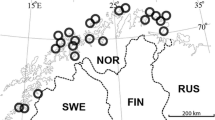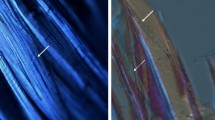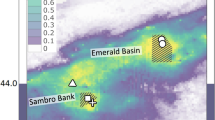Abstract
With an increased appreciation of the frequency of their occurrence, large organic falls such as sunken wood and whale carcasses have become important to consider in the ecology of the oceans. Organic-rich deep-sea falls may play a major role in the dispersal and evolution of chemoautotrophic communities at the ocean floor, and chemosynthetic symbiotic, free-living, and attached microorganisms may drive the primary production at these communities. However, little is known about the microbiota thriving in and around organic falls. Our aim was to investigate and compare free-living and attached communities of bacteria and archaea from artificially immersed and naturally sunken wood logs with varying characteristics at several sites in the deep sea and in shallow water to address basic questions on the microbial ecology of sunken wood. Multivariate indirect ordination analyses of capillary electrophoresis single-stranded conformation polymorphisms (CE-SSCP) fingerprinting profiles demonstrated high similarity of bacterial and archaeal assemblages present in timbers and logs situated at geographically distant sites and at different depths of immersion. This similarity implies that wood falls harbor a specialized microbiota as observed in other ecosystems when the same environmental conditions reoccur. Scanning and transmission electron microscopy observations combined with multivariate direct gradient analysis of Bacteria CE-SSCP profiles demonstrate that type of wood (hard vs. softwood), and time of immersion are important in structuring sunken wood bacterial communities. Archaeal populations were present only in samples with substantial signs of decay, which were also more similar in their bacterial assemblages, providing indirect evidence of temporal succession in the microbial communities that develop in and around wood falls.








Similar content being viewed by others
References
Austin B, Allen DA, Zachary A, Belas MR, Colwell RR (1979) Ecology and taxonomy of bacteria attaching to wood surfaces in a tropical harbor. Can J Microbiol 25:447–461
Baco AR, Smith CR, Peek AS, Roderick GK, Vrijenhoek RC (1999) The phylogenetic relationships of whale-fall vesicomyid clams based on mitochondrial COI DNA sequences. Mar Ecol Progr 1982:37–147
Blackwood CB, Hudleston D, Zak DR, Buyer JS (2007) Interpreting ecological diversity indices applied to terminal restriction fragment length polymorphism data: insights from simulated microbial communities. Appl Environ Microbiol 73:5276–5283
Brunn AF (1959) General introduction to the reports and list of deep-sea stations. Galathea Report 1:7–28
Buchan S, Newell SY, Butler M, Biers EJ, Hollibaugh JT, Moran MA (2003) Dynamics of bacterial and fungal communities on decaying salt marsh grass. Appl Environ Microbiol 69:6676–6687
Clarke KR, Warwick RW (2001) Change in marine communities: an approach to statistical analysis and interpretation, 2nd edn. Primer-E, Plymouth
Cundell A, Mitchell R (1977) Microbial succession on a wooden surface exposed to the sea. Int Biodeterior Bull 13:67–73
Curtis TP, Sloan WT (2004) Prokaryotic diversity and its limits: microbial community structure in nature and implications for microbial ecology. Curr Opin Microbiol 7:221–226
Delbès C, Moletta R, Godon JJ (2000) Monitoring of activity dynamics of an anaerobic digester bacterial community using 16 S rRNA polymerase chain reaction–single-strand conformation polymorphism analysis. Environ Microbiol 2:506–515
Deming JW, Reysenbach AL, Macko SA, Smith CR (1997) Evidence for the microbial basis of a chemoautotrophic invertebrate community at a whale fall on the deep seafloor: bone-colonizing bacteria and invertebrate endosymbionts. Microsc Res Tech 37:162–170
Desbruyères D, Deming JW, Dinet A, Khripounoff A (1985) Réactions de l’écosystème benthique profond aux perturbations: nouveaux résultats expérimentaux. In: Laubier L, Monniot C (eds) Peuplements Profonds du Golfe de Gascogne. IFREMER, Brest (France), pp 193–208
Distel DL, Baco AR, Chuang E, Morrill W, Cavanaugh C, Smith CR (2000) Do mussels take wooden steps to deep-sea vents? Nature 403:725–726
Fekete RA, Miller MJ, Chattoraj DK (2003) Fluorescently labeled oligonucleotide extension: a rapid and quantitative protocol for primer extension. Biotechniques 35:90–94
Fromin N, Hamelin J, Tarnawski S, Roesti D, Jourdain-Miserez K, Forestier N, Teyssier-Cuvelle S, Gillet F, Aragno M, Rossi P (2002) Statistical analysis of denaturing gel electrophoresis (DGE) fingerprinting patterns. Environ Microbiol 4:634–643
Fuhrman JA, Hewson I, Schwalbach MS, Steele JA, Brown MV, Naeem S (2006) Annually reoccurring bacterial communities are predictable from ocean conditions. Proc Natl Acad Sci U S A 103:13104–13109
Ghiglione JF, Larcher M, Lebaron P (2005) Spatial and temporal scales of variation in bacterioplankton community structure in the NW Mediterranean Sea. Aquat Microb Ecol 40:229–240
Ghiglione JF, Mevel G, Pujo-Pay M, Mousseau L, Lebaron P, Goutx M (2007) Diel and Seasonal Variations in Abundance, Activity, and Community Structure of Particle-Attached and Free-Living Bacteria in NW Mediterranean Sea. Microb Ecol 54:217–231
Ghiglione JF, Palacios C, Marty JC, Mével G, Labrune C, Conan P, Pujo-Pay M, Garcia N, Goutx M (2008) Role of environmental factors for the vertical distribution (0–1000 m) of marine bacterial communities in the NW Mediterranean Sea. Biogeosciences 5:2131–2164
Glover AG, Goetze E, Dahlgren TG, Smith CR (2005) Morphology, reproductive biology and genetic structure of the whale-fall and hydrothermal vent specialist, Bathykurila guaymasensis Pettibone, 1989 (Annelida: Polynoidae). Mar Ecol 26:223–234
Holt DM, Jones EB (1983) Bacterial degradation of lignified wood cell walls in anaerobic aquatic habitats. Appl Environ Microbiol 46:722–727
Hong H, Pruden A, Reardon K (2006) Comparison of CE-SSCP and DGGE for monitoring a complex microbial community remediating mine drainage. J Microbiol Meth 69:52–64
Jones SE, Shade AL, McMahon KD, Kent AD (2007) Comparison of primer sets for use in automated ribosomal intergenic spacer analysis of aquatic bacterial communities: an ecological perspective. Appl Environ Microbiol 73:659–662
Jorgensen BB, Boetius A (2007) Feast and famine–microbial life in the deep-sea bed. Nat Rev Microbiol 5:770–781
Jurgens JA, Blanchette RA, Carlson DN (2003) Evaluating the wooden remnants of Tektas Burnu shipwreck. In: Koestler RJ, Koestler VH, Charola AE, Nieto-Fernandez FE (eds) Art, biology and conservation: biodeterioration of works of art. Metropolitan Museum of Art, New York, pp 390–407
Kiel S, Goedert JL (2006) Deep-sea food bonanzas: early Cenozoic whale-fall communities resemble wood-fall rather than seep communities. Proc Biol Sci 273:2625–2631
Knudsen J (1961) The bathyal and abyssal Xylophaga (Pholadidae, Bivalvia). Galathea Report 5:163–209
Kohlmeyer J (1978) Bacterial attack on wood and cellophane in the deep sea. In: Oxley, TA, Becker, G, Allsopp, D (eds.) Biodeterioration: the proceedings of the Fourth International Biodeterioration Symposium The Pitman international series in applied biology. International Biodeterioration Symposium 4, Berlin
Kubartová A, Moukoumi J, Béguiristain T, Ranger J, Berthelin J (2007) Microbial diversity during cellulose decomposition in different forest stands: I. Microbial communities and environmental conditions. Microb Ecol 54:393–405
Lee D, Zo Y, Kim S (1996) Non-radioactive method to study genetic profiles of natural bacterial communities by PCR-singlestrand-conformation polymorphism. Appl Environ Microbiol 62:3112–3120
Leschine SB (1995) Cellulose degradation in anaerobic environments. Ann Rev of Microbiol 49:399–426
Ljungdahl LG, Eriksson K-E (1985) Ecology of microbial cellulose degradation. Adv Microb Ecol 66:237–299
Loisel P, Harmand J, Zemb O, Latrille E, Lobry C, Delgenes JP, Godon JJ (2006) Denaturing gradient electrophoresis (DGE) and single-strand conformation polymorphism (SSCP) molecular fingerprintings revisited by simulation and used as a tool to measure microbial diversity. Environ Microbiol 8:720–731
Lorion J, Duperron S, Gros O, Cruaud C, Samadi S (2009) Several deep-sea mussels and their associated symbionts are able to live both on wood and on whale falls. Proc Biol Sci 276:177–185
Lynd LR, Weimer PJ, Willem HZ, Pretorius IS (2002) Microbial cellulose utilization: Fundamentals and Biotechnology. Microb Mol Biol Rev 66:506–577
Magurran AE (2004) Measuring biological diversity. Blackwell, Malden
Moeseneder MM, Arrieta JM, Muyzer G, Winter C, Herndl GJ (1999) Optimization of terminal-restriction fragment length polymorphism analysis for complex marine bacterioplankton communities and comparison with denaturing gradient gel electrophoresis. Appl Environ Microbiol 522:3518–3525
Mouzouras R, Gareth Jones EB, Venkatasamy R, Holt DM (1988) Microbial decay of lignocellulose in the marine environment. In: Thompson MF, Sarojini R, Nagabhushanam R (eds) Marine biodeterioration advances techniques applicable to the Indian Ocean. Balkema, Rotterdam
Muyzer G, de Waal E, Uitterlinden A (1993) Profiling of complex microbial populations by denaturing gradient gel electrophoresis analysis of polymerase chain reaction amplified genes coding for 16S rRNA. Appl Environ Microbiol 59:695–700
Pailleret M, Saedlou N, Palacios C, Zbinden M, Lebaron P, Gaill F, Prive-Gill C (2007) Identification of natural sunken wood samples. C R Palevol 6:463–468
Palacios C, Zettler E, Amils R, Amaral-Zettler L (2008) Contrasting microbial community assembly hypotheses: a reconciling tale from the Rio Tinto. PLoS ONE 3:e3853
Ramette A (2007) Multivariate analyses in microbial ecology. FEMS Microbiol Ecol 62:142–160
Reysenbach A-L, Pace N (1995) Reliable amplification of hyperthermophilic archaeal 16 S rRNA genes by PCR. In: Robb F, Place A (eds) Thermophiles. Cold Spring Harbor, New York, pp 101–106
Rouse GW, Goffredi SK, Vrijenhoek RC (2004) Osedax: bone-eating marine worms with dwarf males. Science 305:668–671
Schmidt O, Nagashima Y, Liese W, Schmitt U (1987) Bacterial wood degradation studies under laboratory conditions and in lakes. Holzforschung 41:137–140
Smith CR, Baco AR (2003) Ecology of whale falls at the deep-sea floor. In: Gibson RN, Atkinson RJA (eds) Oceanography and Marine Biology: an Annual Review, vol 41. Taylor & Francis, New York, pp 311–354
Smith CR, Kuker H, Wheatcroft RA, Jumars PA, Deming JW (1989) Vent fauna on whale remains. Nature 341:27–28
ter Braak CJF (1994) Canonical community ordination. Part I: Basic theory and linear methods. Ecoscience 1:127–140
ter Braak CJF, Prentice IC (1988) A theory of gradient analysis. Adv Ecological Res 18:93–138
ter Braak CJF, Šmilauer P (2002) CANOCO Reference Manual and CanoDraw for Windows User’s Guide: Software for Canonical Community Ordination (version 45). Microcomputer Power, Ithaca
ter Braak CJF, Verdonschot PFM (1995) Canonical correspondence analysis and related multivariate methods in aquatic ecology. Aquat Sci 57:153–289
Tringe SG, von Mering C, Kobayashi A, Salamov AA, Chen K, Chang HW, Podar M, Short JM, Mathur EJ, Detter JC, Bork P, Hugenholtz P, Rubin EM (2005) Comparative metagenomics of microbial communities. Science 308:554–557
Turnnicliffe V, McArthur AG, McHugh D (1998) A biogeographical perspective of the deep-sea hydrothermal vent fauna. Advances in Marine Biology 34:353–442
Wolff T (1979) Macrofaunal utilization of plant remains in the deep sea. Sarsia 64:117–113
Zemb O (2007) SAFUM: statistical analysis of SSCP fingerprints using PCA projections, dendrograms and diversity estimators. Mol Ecol Notes 7:767–770
Zinger L, Gury J, Giraud F, Krivobok S, Gielly L, Taberlet P, Geremia RA (2007) Improvements of polymerase chain reaction and capillary electrophoresis single-strand conformation polymorphism methods in microbial ecology: Toward a high-throughput method for microbial diversity studies in soil. Microb Ecol 54:203–216
Acknowledgments
We thank J. Ghiglione, O. Zemb, and N. West for insights into CE-SSCP analysis and L. Intergaglia, M. Bourrant (OOB, France), and A. Boetius (MPI, Germany) for help with wood implantation experiments. We are indebted to A. Baco (WHOI, USA), who provided California sample and C. Smith (Univ. Hawaii, USA) for his advice and encouragement on wood falls work. We thank S. Duperron (Univ. Pierre et Marie Curie, France), C. Smith, and two anonymous reviewers for inputs on manuscript preparation. We are thankful to the sailors and divers from the OOB and captain and crew from the R/V Alis. Scanning and transmission electron microscopies were performed at the Service de Microscopie Electronique, IFR 83 de Biologie Integrative-CNRS/Paris VI. This work has been financed by a Marie Curie Posdoctoral Fellowship to C.P. and by DIWOOD project (PI F.G.).
Author information
Authors and Affiliations
Corresponding author
Rights and permissions
About this article
Cite this article
Palacios, C., Zbinden, M., Pailleret, M. et al. Highly Similar Prokaryotic Communities of Sunken Wood at Shallow and Deep-Sea Sites Across the Oceans. Microb Ecol 58, 737–752 (2009). https://doi.org/10.1007/s00248-009-9538-4
Received:
Accepted:
Published:
Issue Date:
DOI: https://doi.org/10.1007/s00248-009-9538-4




